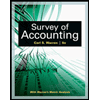
a
Introduction:
Segment disclosures: ASC 280 specifies disclosures required for each reportable segment. The following are the quantifiable and descriptive information that must be disclosed for each segment.
- General information must be disclosed regarding how the company classifies and identifies each reportable segment, type of products and services
- Number of each separately reportable segment should include information of each segment profit or loss and segment assets
- Measurement of profit a firm must disclose its revenue, interest earned, interest expenses,
depreciation and other expenses - Segment assets information about assets of each segment.
- Reconciliations to consolidated totals segment disclosure must also consider reconciliations between all the reportable segments.
The purpose of requiring segment information in financial statements.
b
Introduction:
Segment disclosures: ASC 280 specifies disclosures required for each reportable segment. The following are the quantifiable and descriptive information that must be disclosed for each segment.
- General information must be disclosed regarding how the company classifies and identifies each reportable segment, type of products and services
- Number of each separately reportable segment should include information of each segment profit or loss and segment assets
- Measurement of profit a firm must disclose its revenue, interest earned, interest expenses, depreciation and other expenses
- Segment assets information about assets of each segment.
- Reconciliations to consolidated totals segment disclosure must also consider reconciliations between all the reportable segments.
The factors that should be considered when attempting to decide how products should be grouped to determine a single business segment.
c
Introduction:
Segment disclosures: ASC 280 specifies disclosures required for each reportable segment. The following are the quantifiable and descriptive information that must be disclosed for each segment.
- General information must be disclosed regarding how the company classifies and identifies each reportable segment, type of products and services
- Number of each separately reportable segment should include information of each segment profit or loss and segment assets
- Measurement of profit a firm must disclose its revenue, interest earned, interest expenses, depreciation and other expenses
- Segment assets information about assets of each segment.
- Reconciliations to consolidated totals segment disclosure must also consider reconciliations between all the reportable segments.
The options available for C Inc. for disclosure of its new antihistamine product line.
Want to see the full answer?
Check out a sample textbook solution
Chapter 13 Solutions
Advanced Financial Accounting
- How can I solve this financial accounting problem using the appropriate financial process?arrow_forwardPlease provide the solution to this general accounting question using proper accounting principles.arrow_forwardCan you solve this general accounting problem using accurate calculation methods?arrow_forward
- Please provide the answer to this financial accounting question with proper steps.arrow_forwardCan you solve this financial accounting question using valid financial methods?arrow_forwardPlease explain the solution to this general accounting problem using the correct accounting principles.arrow_forward
 Survey of Accounting (Accounting I)AccountingISBN:9781305961883Author:Carl WarrenPublisher:Cengage Learning
Survey of Accounting (Accounting I)AccountingISBN:9781305961883Author:Carl WarrenPublisher:Cengage Learning Financial Accounting: The Impact on Decision Make...AccountingISBN:9781305654174Author:Gary A. Porter, Curtis L. NortonPublisher:Cengage Learning
Financial Accounting: The Impact on Decision Make...AccountingISBN:9781305654174Author:Gary A. Porter, Curtis L. NortonPublisher:Cengage Learning Cornerstones of Financial AccountingAccountingISBN:9781337690881Author:Jay Rich, Jeff JonesPublisher:Cengage Learning
Cornerstones of Financial AccountingAccountingISBN:9781337690881Author:Jay Rich, Jeff JonesPublisher:Cengage Learning Managerial AccountingAccountingISBN:9781337912020Author:Carl Warren, Ph.d. Cma William B. TaylerPublisher:South-Western College Pub
Managerial AccountingAccountingISBN:9781337912020Author:Carl Warren, Ph.d. Cma William B. TaylerPublisher:South-Western College Pub Financial And Managerial AccountingAccountingISBN:9781337902663Author:WARREN, Carl S.Publisher:Cengage Learning,
Financial And Managerial AccountingAccountingISBN:9781337902663Author:WARREN, Carl S.Publisher:Cengage Learning, EBK CONTEMPORARY FINANCIAL MANAGEMENTFinanceISBN:9781337514835Author:MOYERPublisher:CENGAGE LEARNING - CONSIGNMENT
EBK CONTEMPORARY FINANCIAL MANAGEMENTFinanceISBN:9781337514835Author:MOYERPublisher:CENGAGE LEARNING - CONSIGNMENT





